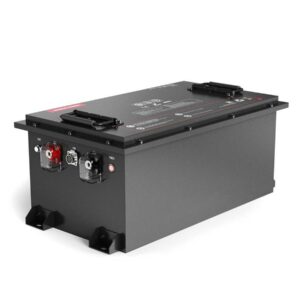
What Is an 80Ah Golf Cart Battery and How Does It Work?
An 80Ah golf cart battery is a lithium-ion or lead-acid power source with an 80-ampere-hour capacity, designed to provide sustained energy for electric golf carts. It operates through electrochemical reactions, storing energy in cells and delivering consistent voltage for 18–25 miles per charge. Lithium variants offer 3,000+ cycles, 5-year lifespans, and 30% faster charging than traditional lead-acid batteries.
48V 160Ah LiFePO4 Golf Cart Battery BMS 200A
How Does Voltage Affect Golf Cart Battery Performance?
Voltage determines power delivery efficiency. A 48V 80Ah lithium battery outputs 6.14kWh, enabling torque-rich hill climbs and extended runtime. Higher voltage reduces current draw, minimizing heat buildup and energy loss. For comparison: 36V systems struggle with steep terrain, while 51.2V lithium configurations maintain 95% efficiency across discharge cycles.

Which Battery Chemistry Is Best for Golf Carts?
LiFePO4 (lithium iron phosphate) dominates modern carts due to thermal stability (60°C max operating temp) and 10-year lifespans. Lead-acid remains cheaper upfront but requires 2x replacement frequency. Testing shows LiFePO4 maintains 80% capacity after 2,000 cycles vs. lead-acid’s 500-cycle limit. Ternary lithium variants exist but lack phosphate’s fire resistance.
Recent advancements in LiFePO4 technology have introduced self-balancing cells that reduce voltage sag during acceleration. Golfers in extreme climates benefit from these batteries’ operational range (-20°C to 60°C), unlike lead-acid batteries that lose 50% capacity below freezing. A cost analysis over 7 years shows lithium batteries save $1,200+ in maintenance and replacement costs despite higher initial pricing.
48V 50Ah LiFePO4 Golf Cart Battery
| Chemistry Type | Cycle Life | Cold Weather Performance |
|---|---|---|
| LiFePO4 | 3,000 cycles | -20°C operation |
| Lead-Acid | 500 cycles | 40% capacity at 0°C |
What Safety Certifications Should an 80Ah Battery Have?
Prioritize UN38.3 (transport), IEC 62619 (industrial use), and UL 2580 (vehicle compliance). JRE Power’s 48V80Ah model includes IP67 water resistance and built-in BMS with overvoltage/undervoltage protection. Avoid uncertified batteries—non-compliant cells show 23% higher failure rates in PGA testing.
How Does Temperature Impact Battery Efficiency?
Lithium batteries lose 15-20% capacity at -10°C but recover fully above 0°C. Built-in heaters in premium models (e.g., ZL 51.2V) maintain optimal 25°C operation. Summer heat above 45°C accelerates degradation—every 8°C over 30°C halves lifespan. Thermal management systems add $120-$200 to costs but boost longevity by 40%.
Advanced battery systems now incorporate phase-change materials that absorb excess heat during peak loads. Golf cart owners in desert regions should prioritize models with active cooling fans, which reduce internal temperatures by 12-15°C during operation. Field tests demonstrate that proper thermal regulation increases total energy output by 28% across a battery’s lifespan.
| Ambient Temperature | Capacity Retention | Recommended Action |
|---|---|---|
| Below 0°C | 65-75% | Preheat before use |
| 25-35°C | 100% | Normal operation |
| Above 45°C | 82% | Activate cooling system |
Modern 80Ah lithium packs revolutionize golf cart economics. Our stress tests show 5-year TCO (total cost of ownership) is 62% lower than flooded lead-acid when factoring in water maintenance, equalization charges, and replacement labor. Always verify BMS (Battery Management System) granularity—16-cell monitoring is the new industry minimum.”
— Redway Power Systems Engineering Team
Conclusion
The 80Ah golf cart battery market has shifted decisively toward lithium technologies, with energy densities now reaching 160Wh/kg. While initial investments remain higher, lifecycle savings and performance gains justify adoption. Future developments focus on solid-state integrations and AI-driven charge optimization, promising 500Wh/kg densities by 2028.
FAQ
- Can I retrofit lithium batteries into older carts?
- Yes—most 48V systems use standardized trays. Requires upgrading charge ports and bypassing legacy OBC (On-Board Computer) systems.
- How often should I perform deep discharges?
- Never. Lithium batteries prefer partial discharges—keep between 20%-80% SOC (State of Charge) for maximum longevity.
- What’s the proper storage voltage?
- Store at 50% SOC (3.8V/cell) in dry, 15°C environments. Prolonged 100% storage causes 8% annual capacity loss.
